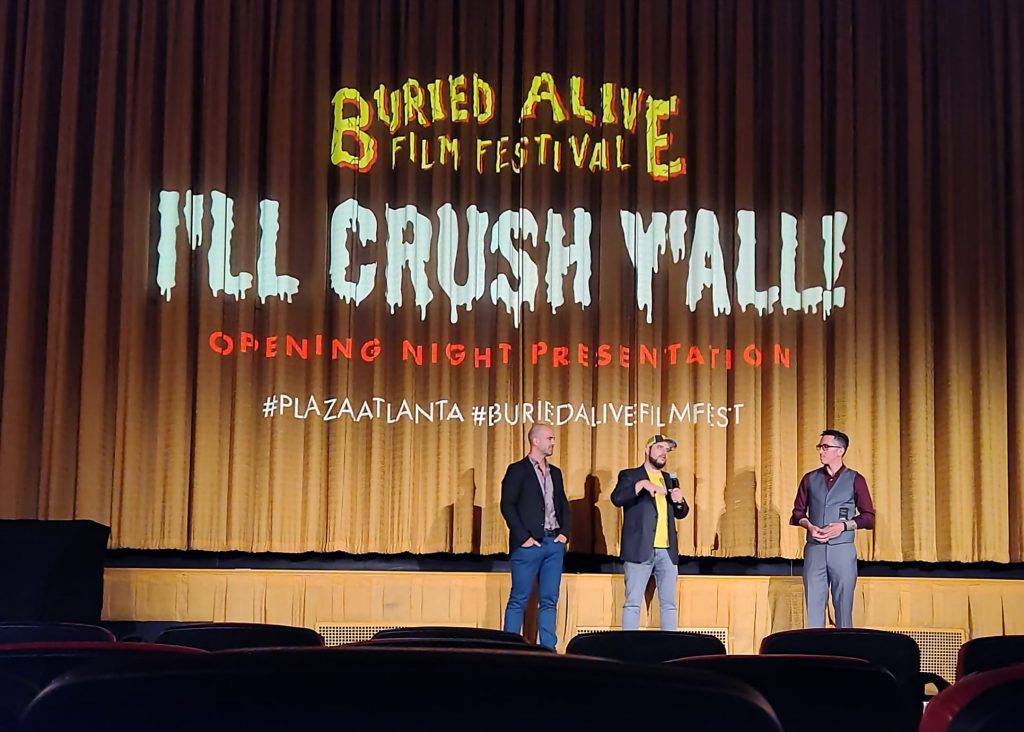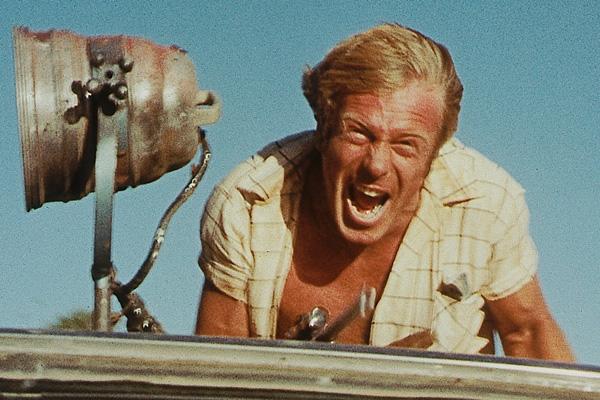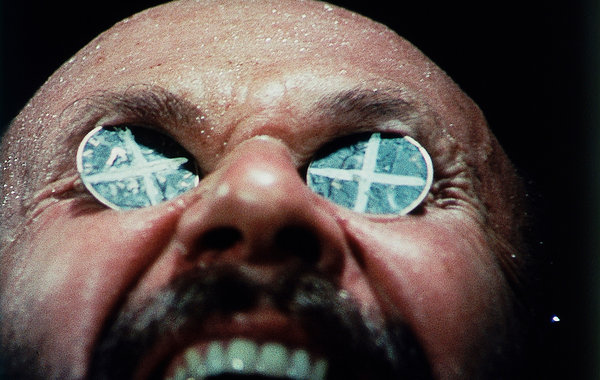by Melanie Crew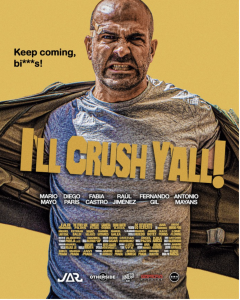
Managing Editor
Kike Narcea’s I’LL CRUSH Y’ALL (2023), was the opening night feature at the 16th annual Buried Alive Film Festival (BAFF), Atlanta’s Premiere Horror Film Festival, which ran Sept. 29 – Oct. 1, 2023, invading the historic Plaza Theatre once again. Narcea’s action-packed gut punch of a film is crushing the genre film festival circuit across the US with two wins so far under its bare-knuckle belt, winning the Audience Choice Award at Fantastic Fest during its world premiere in Austin TX, and hours after this interview, the film took in another win and was voted Best Feature at Buried Alive. There’s nowhere to go now for this killer film, but up!
ATLRetro sat down with actor Mario Mayo Piedra [“Gabriel”/”Tarado”] and one of the film’s producers Jaime Arnaiz Rebollo of JAR Produccion in the Twin Peaks-inspired room at The Plaza to get down to brass tacks about the film, the inspirations behind the making of I’ll CRUSH Y’ALL and the current state of action/horror film in Spain.
ATLRetro: Are you guys having a good time at Buried Alive Film Festival? Favorite films you’ve seen at the festival?
Jaime Arnaiz Rebollo: Great question. First of all, we’d like to give a big shout out to Josh Gould the Director of the festival. He has treated us great, and we are actually feeling like we’re home over here. The theatre is amazing. The smell, whenever you enter, is like coming back to our youth. I mean, this is a very nice place, the theatre inside is also, and the audience was great. So, yeah, we are having a really good time. And from my point of view, the project that I liked most from what we saw is a short film called “Bookworm” directed by a Spanish guy also, named Javier Yanez. It’s actually very interesting. It’s related to manga, and it has some horror. It’s about a librarian. It’s pretty interesting.
Mario Mayo Piedra: We have seen a lot of short films, and we were very interested in “Bookworm.” I have seen a lot of short films with many good qualities and the features are great, too.
 J: We saw this 10th Anniversary screening of THE DEMON’S ROOK, directed by James Sizemore and it was a very interesting movie. It was selected for Sitges and Fantasia and other places. The movie was very interesting, especially since they had such a low budget. They had this props designer that made these awesome devils and monsters.
J: We saw this 10th Anniversary screening of THE DEMON’S ROOK, directed by James Sizemore and it was a very interesting movie. It was selected for Sitges and Fantasia and other places. The movie was very interesting, especially since they had such a low budget. They had this props designer that made these awesome devils and monsters.
M: And zombies.
J: It looked very good.
M: Yes, I remember James’ film.
J: Yeah, we were here also with the producer team. He’s from Atlanta and he was actually really excited about screening the movie here. Josh is part of the cast also. The movie is very funny actually.
M: Yes, it was very funny.
How did you get involved with I’LL CRUSH Y’ALL? Any special backstory about getting involved in this film?
J: Yeah, it’s all Mario’s fault. (laughs) I mean, I’m the producer, along with four other producers from Spain who are Kiko and Javie Prada (The Other Side Films), Bruno Martin, and Jesus Loniego, along with our own company, but we all got together because of Mario. He’s the spiritual producer of the movie who has been behind our backs the whole time whipping us and crushing us all in order to motivate us. He’s been the heart of the movie, the project.
M: I have a love for working in movies like this kind because I think in Spain we have a lot of potential for doing these kinds of movies, but I think in this moment, we have a poor production of action movies. I think we can do more and more and more, and a good job of these movies, actions movies. For example, our neighbor France makes a lot of action movies, but in Spain…
J: We don’t do that many over there in Spain, no.
M: Yes. And I think we can do it.
J: Actually, I agree with Mario. One of our main goals is to create this branch of movies of live action. We have many references in Europe, in Asia, and the States about live action, but we don’t have that much content of live action in terms of content in Spain, but we have Mario who has this huge camera presence and a very strong physique-
huge camera presence and a very strong physique-
M: Thank you.
J: -and he is a very good actor also, so we want him and all our cast actually to become new action heroes and new action villains. That would be only if we could go step by step by step by creating new projects and I’LL CRUSH Y’ALL did really well and it’s doing very well. We are now preparing the sequel, I’LL CRUSH Y’ALL 2, where Mario is going to be smashing more heads (laughs).
M: Ha!
The film just won the Audience Choice award at Fantastic Fest. What was it like winning that award at the film’s world premiere?
J: Goosebumps. I mean it’s awesome. I’m an independent producer with this low budget movie and with our own resources. We don’t have any funds from the government from Spain, no funds from a funding company. We did it with our own resources. And getting this award, this Audience Award at Fantastic Fest, which is one of the ten largest genre festivals in the world, it’s an awesome achievement. Last year, this award was won by THE MENU, so last year THE MENU was here and this year I’LL CRUSH Y’ALL is here, so not bad at all. I mean, we are actually living the American dream. This is the land of opportunities, and this is actually a small one getting a great opportunity, so I think that this is actually paying off for the year we invested in this, not only this movie, but, our careers, professionally.
M: It was great! Now I am at the same level as Ralph Fiennes, as an actor. No?
J: Yeah, yeah, yeah.
M: Sorry, Ralph. (laughs)
J: And it’s also been an amazing time because we didn’t know actually how the movie was going to do in the market and as soon as we got the award, the very next day we started getting proposals and opportunities, so right now we are just making decisions for the movie to be screened all around the world.
Clearly this is a very physical film, it being about “crushing” folks. What was the most physically difficult part to film?
M: Maybe all of the filming – we filmed the movie in six weeks and during the filming I lost more than 5 kilos because it was very physical and I sweated a lot, a lot, repeat, repeat, repeat, but I think that is important because you can choose the better frames, the better scenes and I remember all  of the filming was very hard.
of the filming was very hard.
Were the fight scenes choreographed or were most of them improv?
M: No, they were prepared.
J: They were prepared because Kike Narcea, he’s a great choreographer, he’s the director but he’s a great choreographer because he’s seen a lot of movies (Asian, French, Italian, German, all of the countries) and he loves action movies. And when we were on the set he had very clear ideas.
So, he pretty much had a vision?
Both: Yes, yes.
J: Our director is a geek.
As we all are.
J: Yes. That is why we are here. He’s a geek. He has a great background in action movies and not only action movies, but all types of cinemas and he really had a clear idea of the movie in his mind. So, whenever we were going to shoot any scene he would sit down with the team beforehand and then after that with the cast and he will explain everything to the team first, then he will explain everything to the cast and then they will try to do some testing, but he had everything ready, like “You are launching the punch and halfway I’m cutting so you don’t need to do it all the way.” So, he has perfectly clear in his mind the editing of the movie, so that actually helps us a lot. Although, there is a scene in the movie that was improvised. Only one scene. Can you guess?
Was that the pallet scene?
Both: Yes, yes.
I only know that because I was at your Q&A, and it was mentioned there.
J: Yes, it’s actually a very unique scene for us. A very interesting scene.
The pallet scene is where a lot of the comedy kicked in for me.
J: Yes.
So, what was it like working with the dogs?
M: Wow, marvelous. I love dogs. I am more friends with dogs than with people. I have cats, I have a dog and I love animals.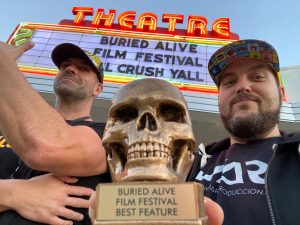
J: It’s great. It was amazing to me. They were very nice.
Did they take direction well from the Director?
J: Yes, so usually you should never shoot with animals or kids because it’s really hard, but on this occasion we were very lucky because the owner of the dogs is one of the cast members. So, this scene where the dogs are actually eating from a guy, they are killing him, and the truth is that, as he is the owner, we just put some jam on him and the dogs were kissing him, but on the screen it actually seems like they are feasting on him. It’s actually very cute. They didn’t die during the movie, a little spoiler, but everybody was like, “Oh the dogs,” you can see them at the beginning of the movie, and I don’t know if people were thinking, “Oh, they are going to die,” but in the end they don’t die and they have a very important role.
M: And their sounds helped a lot for scenes like this [dog eating the man], the sound-
J: The sound designing, yes, we did a great sound design and all the music of the movie, everything just fits perfectly. The music composer is Daniel Maldonado, who is a Spanish composer, and he did a great job. Also, the final song that we have in the movie, which is like the main track, it was composed by the owner of the dogs – he’s the owner of the dogs, the owner of the house, he did the main theme – we got a lot of great things from Diego Paris, thank you for everything Diego – we love you.
Anything else you’d like our audience to know about the film?
J: For sure. We are very happy and pleased about getting this award at Fantastic Fest and hopefully we may get some awards here at Buried Alive. It’s up to the jury. But we are working really hard in order to get the movie on all platforms and theatres. We’ve already got some offers from American distributors, but we want to keep on working, not to just be on the American market but also the whole world and this is because, as I said before, we are really willing to make a new branch of movies, action movies, with Mario as lead role.
And you said you’re working on a sequel?
J: We are working on the sequel. We actually do have half the script and we have the whole plot idea. Also, we are already gathering the actors to cast and gathering the funds. If everything goes well, maybe next year or in two years we will be done with the sequel.
What is your favorite action film from any time period that’s important to you and epitomizes what you love about the action movie genre?
 J: I have two references. I’m not the director, so, for sure this question would be much better answered by Kike, but from my point of view as a producer, I have two references that for me I would like to achieve the quality of entertainment. The first one is a movie called AIRBAG. It’s a Spanish movie directed by Juanma Bajo Ullow. It was a movie shot in the late nineties, early 2000s and is very funny. It’s an action and thrill movie, but it’s all fun and—
J: I have two references. I’m not the director, so, for sure this question would be much better answered by Kike, but from my point of view as a producer, I have two references that for me I would like to achieve the quality of entertainment. The first one is a movie called AIRBAG. It’s a Spanish movie directed by Juanma Bajo Ullow. It was a movie shot in the late nineties, early 2000s and is very funny. It’s an action and thrill movie, but it’s all fun and—
M: Manic comedy.
J: Comedy. Everybody is crazy and the characters are unique people. And I think we have similarities in our movie. And another production I really love is HOME ALONE. I mean, actually, we don’t have Macaulay Culkin in our movie, but we have Mario Mayo, which I think he’s going to have a great career.
There’s actually a line in the movie about HOME ALONE, correct?
J: There’s a line that we actually speak about it and it’s just because Kevin McCallister stays in his house—
M: I am Kevin McCallister.
J: Yes, and he has to keep it from these burglars. Mario is like Kevin McCallister. He has to remain in his house, and he has to keep his house safe from all these people that are coming over. So, more or less, there are some similarities, but I would love as a producer the success of those two movies. I mean, for me HOME ALONE is the best reference along with INDIANA JONES and THE GOONIES—the most well-known movies ever and AIRBAG – I’m pretty sure for every Spanish person thinks it’s one of the funniest movies and I invite you to see it because I’m sure you will enjoy it.
M: I think for example, this movie looks like, more or less, FIRST BLOOD, Sylvester Stallone, he doesn’t want to have problems but problems find him and maybe my character is more or less like Rambo. And also, there is a kind of movie or cinema in Spain called cine kinki (cine quinqui)—
J: Not the English “Kinky.” In Spain in the 80s we had a big problem with drugs, heroin, and we have a lot of crime, and we have this urban tribe called kinki people, which were like outsiders, ex-drug dealers, ex-consumers and they were involved in crime, robbery and stealing and so that way of life was called the kinki life—being underground, and being an outlaw. So, during the late 80s and 90s this new branch of cinema called the kinki cinema was about that type of people. It was just resembling what our society had and in our movie we are showing a little bit of the low-income part of society, so it has some reminders of those kinki movies.
M: Yes.
J: It’s not the same kinki as you have here.
M: No. Many years ago in Spain, many directors were filming film kinki.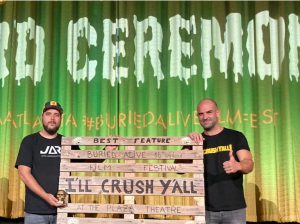
J: So basically, we did a movie to have fun, we enjoyed the filming and what we liked most is that the audience liked the movie. I mean, it’s very interesting how we showed the movie in Spanish and most of the jokes are internal Spanish jokes.
M: Yeah.
J: But we were shocked that the American audience reacted very well with those jokes. Although they didn’t understand all of them they got many of them and also we were told that our translation is not the best and so we have to keep on working on it, but it’s only been the third screening ever, so we’ve only been showing the movie for one week in only five theatres that have seen the movie. And we are just getting the first feedback.
Nice! What’s next for you guys?
M: Now I am working with Alex de la Iglesia in a serial for Netflix, and it’s a small character, but it’s great. Working with Alex is awesome. He is one of my favorite filmmakers. I expect I will work with him again on another project.
J: Well, I’m studying to become a pharmacist. I’m in my fifth year of school for this career. Because cinema is a little like a roller coaster – it’s tough to survive because of this.
M: He’s a great producer. You are going to be a producer, a great producer. There will be more than what we’re doing now.
So, a legal drug dealer then?
J: I’m actually going to spend all the money I get from drug dealing on cinema. But legal drug dealing (laughs). No actually, I’m studying the career, but at the same time I’m doing all of these productions. We are preparing a new movie we are shooting in February which will be directed by Bruno Martin, and we are going to be co-producing it and also I shot three different short films this year.
M: Yes, I am also in this film.
J: He is also in this new film that we are going to film, but as I said, we shot three different short films this year with different genres. One of them is action – fights between the Spanish mob and Chinese mob. We have a drama about a mother and daughter who get evicted from their house and she tells her daughter that they are going on holiday, so the daughter doesn’t realize what is actually going on. We have this other project called SHAKESPEARE IN SMOKE, directed by Francesco Cocco. It’s like an essay about what it is to be an actor your whole life. Three different actors who are different ages, but they all have the same path, and they share their experiences. And I’m in many other projects but at the moment we would like to enjoy and harvest all that we have already planted.

